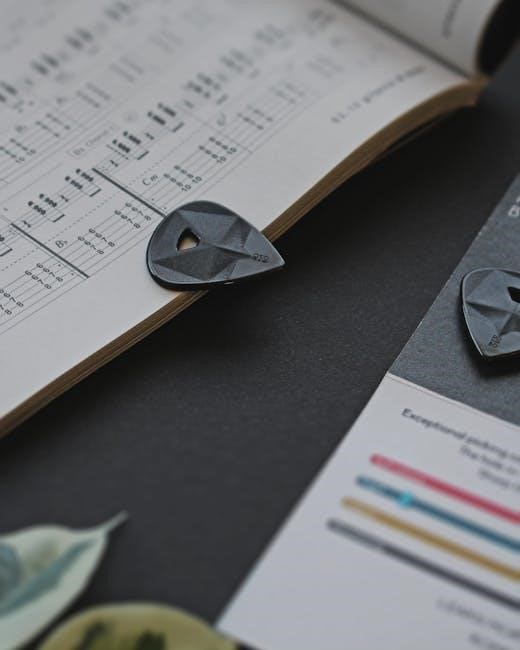Discover the essential concepts of music theory tailored for guitar players. Learn how scales, chords, and rhythm apply to the fretboard, enhancing your creativity and technique. Explore free PDF resources designed to simplify complex ideas, making music theory accessible and practical for all skill levels. Mastering these fundamentals will transform your playing and open doors to new musical possibilities.
Why Music Theory is Essential for Guitarists
Music theory provides the foundation for understanding how music works, empowering guitarists to create, communicate, and collaborate effectively. It enhances creativity, composition, and improvisation skills, allowing players to express ideas more clearly. Knowledge of scales, chords, and rhythm enables guitarists to analyze songs, transcribe melodies, and improvise with confidence. Whether playing solo or with a band, music theory bridges the gap between technique and musicality, making it an indispensable tool for every guitarist.
By mastering theory, guitarists can decode complex musical structures, adapt to new styles, and connect with other musicians on a deeper level. It’s not just about rules—it’s about unlocking endless possibilities for self-expression and growth.
Understanding the Basics of Music Theory
Unlock the fundamentals of music theory by mastering essential concepts like notes, scales, chords, and rhythm. These building blocks form the foundation of music, enabling guitarists to understand and play with precision; Learning basic notation, pitch, and timing simplifies the learning process. By grasping these principles, guitarists can decode musical structures, improvise confidently, and communicate effectively with other musicians. Regular practice and study of these basics will lead to profound improvements in your playing and overall musical understanding.
The Fundamentals of Music Theory
Master the core elements of music theory, including notes, scales, chords, rhythm, and timing. These concepts form the foundation for understanding and playing music effectively on the guitar.
Notes, Scales, and Chords
Understanding notes, scales, and chords is crucial for guitarists. The guitar neck consists of seven natural notes (A-G) and sharps/flats, forming the foundation of music. Major and minor scales are built from these notes, creating emotional depth in music. Chords are groups of notes played together, derived from scales. Open and barre chords are essential for rhythm playing. Dominant, major, and minor chords are fundamental for various genres. Mastering these elements enhances composition and improvisation. Free PDF guides and visual tools like fretboard maps simplify learning these concepts, making them accessible for all skill levels.
Rhythm and Timing
Rhythm and timing are fundamental to guitar playing, governing how notes are played in sequence. Time signatures, note values, and rests define rhythmic structure, while tempo sets the speed. Understanding syncopation and subdivisions enhances feel and precision. Proper timing allows for dynamic expressions and emotional depth in music. Free PDF guides offer exercises to master rhythm, ensuring guitarists can play with accuracy and confidence. These concepts are vital for both solo and collaborative performances, forming the backbone of musical expression.

Guitar-Specific Music Theory Concepts
Explore how music theory applies uniquely to the guitar, focusing on the fretboard layout, chord voicings, and techniques like bends and slides. These concepts tailor theory to the guitar’s strengths, enabling expressive and versatile playing.
The Guitar Neck and Note Maps
Mastering the guitar neck involves understanding note placement and relationships. Note maps visualize each key’s notes across the fretboard, following the circle of fifths. These tools reveal how scales and chords connect, aiding improvisation and composition. By learning note positions and intervals, you can navigate the neck confidently. Free PDF resources, like guitar neck diagrams, simplify this process, making complex concepts accessible. Understanding the guitar’s layout is essential for applying music theory practically and unlocking creative possibilities in your playing.
Chord Construction and Progressions
Chords are built from scales, with each note serving as a foundation for chord construction. Understanding how chords are formed from major and minor scales is crucial for creating harmonious progressions. Guitarists can use chord maps and diagrams to visualize these relationships. Free PDF resources provide exercises and diagrams to master chord shapes and progressions. Learning to construct chords and arrange them logically opens up endless possibilities for composition and improvisation, making music theory a powerful tool for expressive playing and creativity.

Advanced Music Theory Topics
Delve into complex concepts like intervals, modes, and harmonic structures. These advanced techniques enhance composition and improvisation skills, offering deeper musical understanding and creative expression.
Intervals and Modes
Intervals are the building blocks of music, defining the distance between notes. Modes are variations of scales, offering unique emotional colors. Understanding intervals and modes is crucial for improvisation and composition. They allow guitarists to create rich, complex sounds and explore diverse musical styles. Learning these concepts helps in recognizing patterns on the fretboard and enhances your ability to craft meaningful solos and melodies. The Absolute Essentials of Music Theory for Guitar PDF provides detailed insights into these advanced topics, making them accessible for players of all levels to master.
Harmonic Structures and Improvisation
Harmonic structures form the foundation of music, created by chord progressions and scales. Understanding these allows guitarists to improvise effectively, crafting solos that resonate emotionally. Learn how to apply modes, intervals, and chord voicings to create dynamic melodies. The Absolute Essentials of Music Theory for Guitar PDF offers practical insights into harmonic structures, enabling players to explore advanced improvisation techniques. Mastering these concepts will elevate your ability to express yourself musically and develop a unique playing style.

Practical Application of Music Theory
Apply music theory to real-world guitar playing by learning to read tablature, compose melodies, and improvise confidently. Free PDF guides provide exercises and worksheets to master these skills, helping you translate theoretical knowledge into practical results. Whether arranging songs or transposing chords, these resources make complex concepts accessible for all guitarists, from beginners to advanced players.
Reading Music and Tablature
Mastering music notation and tablature is crucial for guitarists to communicate musical ideas effectively. While tablature is a user-friendly system showing strings and frets, standard notation provides deeper insights into rhythm, pitch, and dynamics. Free PDF guides offer exercises to improve reading skills, ensuring guitarists can interpret both systems accurately. These resources often include diagrams and practical drills to enhance understanding. By learning to read music and tablature, guitarists can expand their musical vocabulary and play with greater precision and confidence, whether performing solo or with others.
Transposing and Arranging Music
Transposing and arranging music are essential skills for guitarists, allowing adaptation of songs to different keys or styles. Understanding chord progressions and scales enables seamless transposition, while arranging involves restructuring music to suit personal or ensemble needs. Free PDF resources provide detailed guides on these techniques, offering exercises and examples to master key concepts. By learning to transpose and arrange, guitarists can create unique interpretations of songs, enhancing their versatility and creativity in both solo and collaborative settings. These skills bridge theory and practice, empowering musicians to explore new musical possibilities.

Free PDF Resources for Guitar Music Theory
Access a wealth of free PDF resources dedicated to guitar music theory, including comprehensive guides, workbooks, and tutorials. These materials cover fundamentals, advanced concepts, and practical exercises, ensuring a well-rounded understanding of music theory tailored for guitarists.
Recommended Books and Guides
Enhance your learning with these highly-recommended music theory books for guitar. Titles like Practical Music Theory for Guitar Players and The Ultimate Guide to Guitar Theory offer in-depth insights. Music Theory Fundamentals provides a solid foundation, while Harmony and Ear Training expands your skills. These resources are tailored for guitarists, ensuring practical application and easy understanding. They cover essential concepts like scales, chords, and rhythm, making them indispensable for both beginners and advanced players. Download these free PDF guides to elevate your musical knowledge and technique effectively.
Downloadable Worksheets and Exercises
Reinforce your learning with downloadable worksheets and exercises tailored for guitar music theory. These resources provide hands-on practice with scales, chords, and rhythm. Music Theory ⎻ Workbook includes exercises on notation, intervals, and triads. Practical Music Theory for Guitar Players offers drills for transposing and arranging. These tools help build a strong foundation and improve your skills systematically. Perfect for self-study, they ensure you master concepts through interactive learning. Access these free PDF exercises to enhance your understanding and application of music theory.
Ear Training and Its Importance
Ear training enhances your ability to recognize intervals, chords, and melodies by ear, crucial for improvisation and composition. It strengthens your connection to music, making playing and composing more intuitive and expressive.
Developing Your Musical Ear
Developing your musical ear is a vital skill for guitarists, enabling you to recognize intervals, chords, and scales by ear. Start with simple listening exercises, such as identifying notes or chord progressions in songs. Regular practice improves pitch recognition and rhythm accuracy. Use free PDF resources like ear training guides and worksheets to enhance your skills. Transcribe solos and melodies to refine your ability to replicate music. Over time, your ear will become a powerful tool, aiding composition, improvisation, and collaboration with other musicians.
Listening Exercises for Guitarists
Listening exercises are crucial for guitarists to refine their musical ear and understanding. Begin by identifying chord progressions in popular songs, focusing on common sequences like the 12-bar blues. Practice recognizing intervals and scales used in solos. Use free PDF guides to create structured listening sessions, transcribing riffs and melodies. Pay attention to rhythm and timing, ensuring accuracy. Regular practice enhances your ability to replicate and improvise, making you a more versatile and expressive musician. These exercises bridge theory and application, fostering musical intuition and creativity.
The Benefits of Learning Music Theory
Learning music theory enhances creativity, improves composition skills, and fosters collaboration. It provides a deeper understanding of music, enabling guitarists to express ideas more effectively and confidently.
Enhancing Creativity and Composition Skills
Learning music theory unlocks creative potential by providing a foundation for composing and improvising. Understanding scales, chords, and progressions allows guitarists to craft meaningful melodies and harmonies. Theory enables the creation of structured, emotionally resonant music, while inspiring experimentation with new sounds. It also enhances collaboration, as musicians can communicate ideas more effectively. With resources like free PDF guides and workbooks, guitarists can master these concepts, fostering artistic expression and transforming ideas into compelling compositions. Music theory becomes the tool that bridges inspiration and realization, making creativity limitless.
Improving Collaboration with Other Musicians
Music theory empowers guitarists to collaborate seamlessly with others by providing a shared language. Understanding scales, chords, and rhythm allows clear communication, ensuring everyone is on the same page. This knowledge enables musicians to anticipate changes, adapt to arrangements, and contribute ideas effectively. With resources like free PDF guides, guitarists can master these concepts, fostering teamwork and elevating group performances. Theory bridges the gap between individual creativity and collective harmony, making collaboration more enjoyable and productive for all musicians involved.
Mastering music theory for guitar unlocks endless creative possibilities and enhances technical skills. With free PDF resources available, continuous learning is accessible and rewarding for all guitarists.
Final Thoughts on Mastering Guitar Theory
Mastering guitar theory is a lifelong journey that deeply enriches your musical understanding; Consistent practice and exploration of free PDF resources can accelerate your progress. By grasping concepts like scales, chords, and rhythm, you’ll unlock creativity and enhance your playing. Music theory isn’t just academic—it’s a tool to connect with other musicians and express yourself more effectively. Stay curious, embrace challenges, and apply theory practically to compose, improvise, and grow as a guitarist. The rewards of this journey are immeasurable for any musician.
Encouragement for Continuous Learning
Embrace the journey of learning music theory for guitar with enthusiasm and dedication. Each concept mastered brings you closer to unlocking your full musical potential. Utilize free PDF resources to guide your progress and stay motivated. Consistent practice, even in small doses, fosters growth and creativity. Remember, music theory is a tool to enhance your playing and connection with others. Celebrate every milestone, and don’t hesitate to explore new challenges. The world of music is vast, and your continuous learning will open endless opportunities for expression and collaboration.